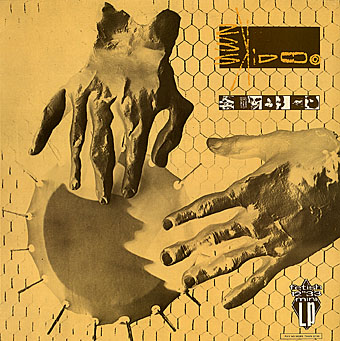
Seven Songs by 23 Skidoo, FM 2008, 1982.
Since I made a post earlier about bad album design, it’s only right to redress the balance somewhat. Neville Brody has long been a favourite designer and something of an influence since it was looking at his work during the 1980s that made me think seriously about design when I’d previously had little interest in the field.
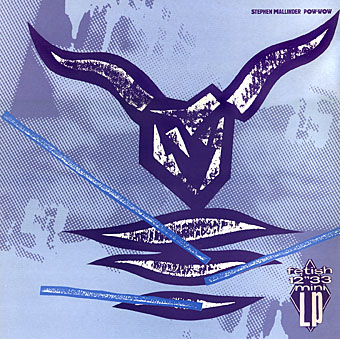
Pow-wow by Stephen Mallinder, FM 2010, 1982.
The record sleeves Brody produced for Fetish Records from 1980–82 are great examples of post punk style that showcase his particularly individual approach to design. This involved much use of hand-crafted elements, whether painted, printed, cast or carved. (In the days before computer design everything had to be pasted together from paper cut-outs, film overlays or PMT [photo-mechanical transfer] prints, with type provided by a professional typesetter.) Some of the Fetish sleeves used three-dimensional work that was then photographed, such as the wooden carvings or plaster hands on the 23 Skidoo sleeves. This approach might have provided a new direction for other sleeve designers but was quickly passed over as the decade progressed in favour of a weak pastiching of Modernist styles and the cultivation of a slick corporatism, much of it watered-down from Brody’s highly influential innovations for The Face magazine.
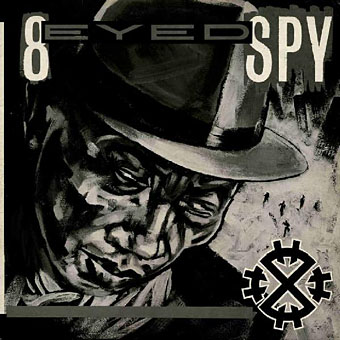
8 Eyed Spy by 8 Eyed Spy, FR 2003, 1981.
Brody has said of the Fetish period:
The musicians on Fetish were also totally open to the idea of me working under my own steam; there has been such a shift in this respect—most groups now take a much bigger hand in design which does not necessarily make for a better cover.
The Graphic Language of Neville Brody, 1988.
The situation is just as bad, if not worse, today. The open-ended nature of digital art has created a situation whereby a given design can be subject to endless revision merely because the client knows that the technology allows changes to be made.
Brody continues to work as a designer even though he’s less visible now, heading his own Research Studios.
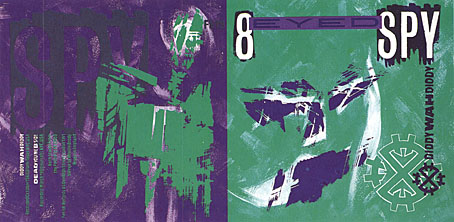
Diddy Wah Diddy by 8 Eyed Spy, FE 19, 1980.
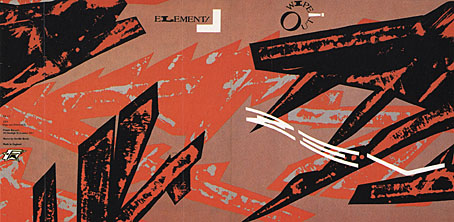
Wipe Out by Z’ev, FE 13, 1982.
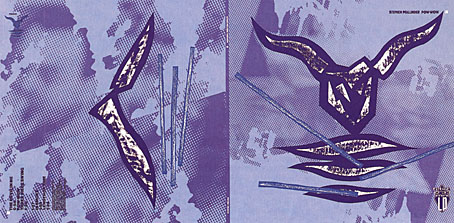
Pow-wow by Stephen Mallinder, FM 2010, 1982.

Temperature Drop by Stephen Mallinder, FE 12, 1981.
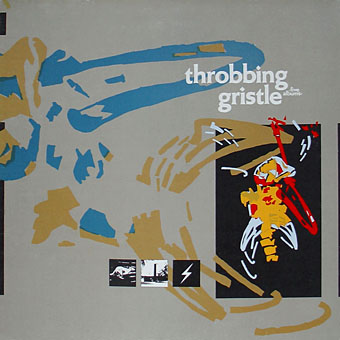
Five Albums by Throbbing Gristle, FUX 001, 1981.
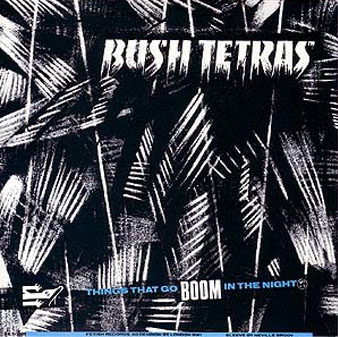
Things That Go Boom In The Night by Bush Tetras, FET 007, 1981.
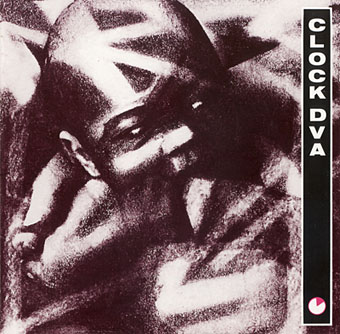
Thirst by Clock DVA, FR2002, 1981.
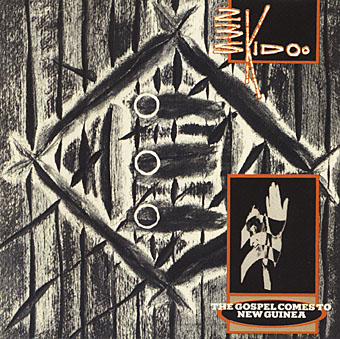
The Gospel Comes To New Guinea by 23 Skidoo, FE 11, 1981.
(This is actually the cover of a CD compilation which somehow gained
three circles that weren’t on the original sleeve.)
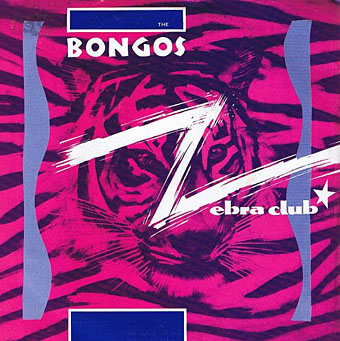
Zebra Club by The Bongos, FE 17, 1982.
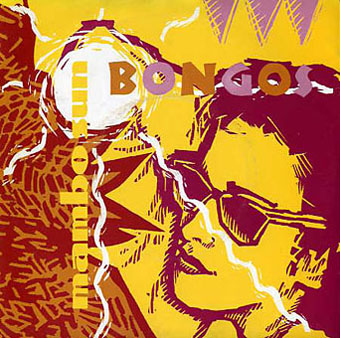
Mambo Sun by The Bongos, FE 18, 1982.
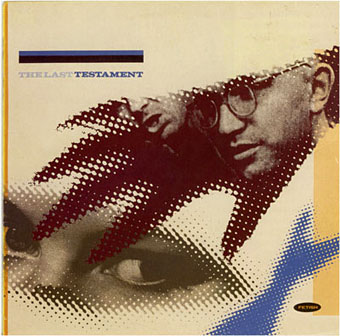
The Last Testament, Various Artists, FR 2011, 1983.
Update: added a couple more sleeves (Bush Tetras and Clock DVA). Since there’s little information about the record company available, I’ve also added Jon Savage’s sleeve note from The Last Testament (1983), the final Fetish release and a compilation which acted as a celebration and epitaph for the label.
I’D IMAGINE IT TO BE SYMPTOMATIC that the word Fetish should have changed in the middle to late 70s, from being a slogan on an obscure Mail Art T Shirt to becoming the tradename of an internationally renowned record label—Maida Vale’s own ‘Home of the Hits’—but that’s showbiz.
AS WAS PRACTISED FOR A BRIEF TIME: Fetish now appears a product of a particular period when the separate streams of pop and avant-garde—the difference being in self-estimation as much as anything else—were thought expedient, cool and all those things, to crossover. In practice, this tended to mean press coverage disproportionate to sales, plenty of amusing attitudes struck, and streams of ill-advised people like myself being persuaded to view such artistes as are on offer here in dark and dingy basements. These last would always give the lie to pop’s brave new world pretensions.
IN THIS PULSATING SCENE, Fetish represented an opportune, if haphazard, meeting of New York, Sheffield, and Hackney. All of these spots have been glamourised to a greater or lesser degree, so you would have thought that this brand name was onto a winner. It is, however, an undoubted sign of human perversity that Fetish’s greatest success was to occur at the point when mogul Rod Pearce was shutting up shop: in early 1982, 23 Skidoo’s ‘Seven Songs’, produced by noted noisemakers Genesis P-Orridge and Peter Christopherson, became NUMBER 1 in the indie charts. Phew! Luckily, insufficient interest combined with too much time spent promoting the Bongos meant that this incredible success was nipped in the bud: disheartened at rock ‘n’ roll’s indifference, Pearcey announced that Fetish was to cease operating. People in polytechnics wept.
MAY I NOW IMAGINE YOU holding what I hope will be a beautifully designed sleeve (although you never can tell) and wondering why you should part with the money? (And, as they used to say, if you’re not going to, please don’t leave fingermarks all over Neville Brody’s labour of love). Apart from all the usual ‘unreleased’ and ‘live tracks’ sales points, you will own 12 tracks from a brief, hothouse period, a temporary delay in the long slide from the Sex Pistols to ABC. You will find preoccupations of the times faithfully represented: the full flowering of ‘industrial’, mature works from your favourite New York noisemakers, and the first UK meshing of punk and funk
1980! 1981! THOSE WERE THE DAYS! Those heady days of idealism are over. The fragile dividing line between art and commerce which Fetish represented has now shattered: Rod Pearce and Perry Haines are now prostituting themselves with King, Genesis P-Orridge and Peter Christopherson with Psychic TV, Adi Newton with DVA, and Neville Brody with the Face. I too, am deeply implicated, having sold my soul similarly to PTV and the Face. How worlds change! Isn’t life tough?
JON SAVAGE
Elsewhere on { feuilleton }
• The album covers archive

INTERESTING!!!
i am 4th year student studying for my BA in Graphic Design and in the process of writing an essay on album design! if you have any more info on fetish records or neville brody record sleeves i would really appreciate it
Hi Dean,
There’s more information about Brody’s Fetish work in The Graphic Language of Neville Brody by NB & Jon Wozencroft (Thames & Hudson, 1988). Some of the scans on this page were taken from that book which is worth reading throughout, not only for the detail about his sleeve designs. I’d imagine you’d be able to find a copy in a library easily enough.
http://www.amazon.co.uk/Graphic-Language-Neville-Brody-v/dp/0500274967/
And for a comprehensive look at a different type of sleeve design, there’s my big post on the work of Barney Bubbles:
http://www.johncoulthart.com/feuilleton/2007/01/20/barney-bubbles-artist-and-designer/
Great stuff, interesting read, do you know who he was influenced by/ where his ideas came from or any artists that his work is similar to vice versa
cheers
james
Hi James. The rather po-faced Wozencroft book doesn’t say much at all about Brody’s influences–make of that what you will. Mention is made of Barney Bubbles and Brody’s having been impressed by Malcolm Garrett’s sleeve design for Orgasm Addict by The Buzzcocks; he likes the Futura typeface a lot.
You won’t find much that resembles these sleeves since few people seemed to notice them at the time. His later work for The Face magazine was hugely influential and poorly-imitated. For a designer with a similar attitude today, I’d recommend you look at the work of Jonathan Barnbrook.
Cheers, yeah Jonathan Barnbrook is a designer that I thought was similar to Brody
Sorry to ask another question but do you have any information on Fetish Records as a company, can’t seem to find that much about them.
Cheers and thank you for taking the time to reply.
James
No problem with that James, I wish I could tell you something but there doesn’t seem much to tell. Formed in London 1979-ish by Rod Pearce, expired in 1982. I’ve added Jon Savage’s sleeve note from The Last Testament to the post since that fleshes out some of the history.
He notes there the curious moment which followed punk when all the rules had collapsed and anything seemed possible. Many interesting bands, labels, things flourished at that point before the Eighties as we think of them now (poppy, glitzy, very commercial and money-oriented) kicked in around the end of 1982. Simon Reynolds’ Rip It Up and Start Again: Postpunk 1978-84 is a good history of the era.
Brodybunch
We used to call him Brodchenko!!!
Hi,
I have record by my old group L.O.K from the 70s. I played drums and wrote the music to FUN HOUSE and STARLET LOVE. The lyrics were by A.A. Pritchard
with grapfics by pluribus with looks like your design, which I always loved?
Any comments?
Rainer
Hi Rainer. That was the first Fetish Records release and, as far as I’m aware, pre-dates Neville Brody’s involvement with the label which is the subject of this post. The “Pluribus” credit would seem to confirm that since Brody always used his own name as a credit.
Hi,
Nice article.
I found this article where there’s some information about what influenced Neville Brody at http://alexandraavila88.blogspot.com/2008/11/411-on-neville-brody.html.
Hopefully it will be useful to someone.